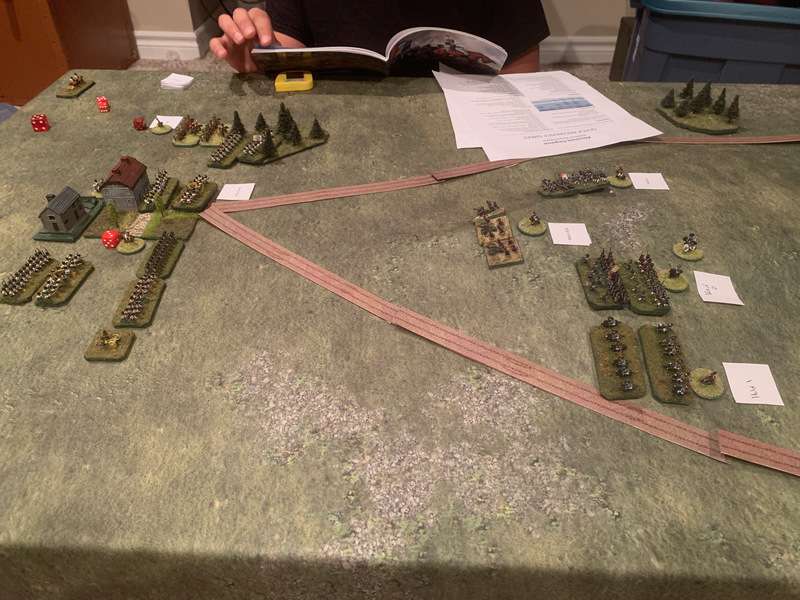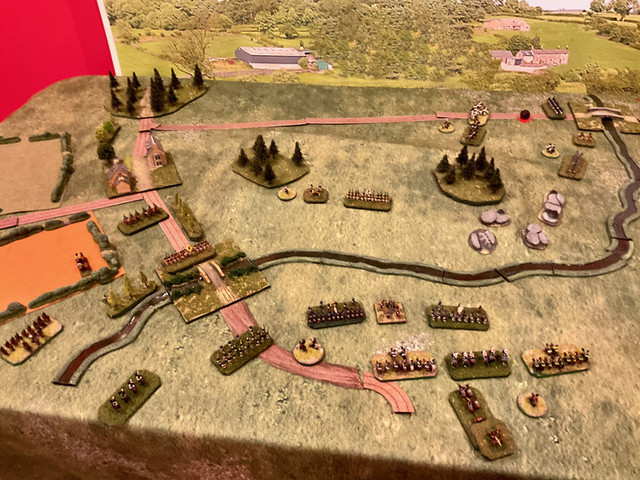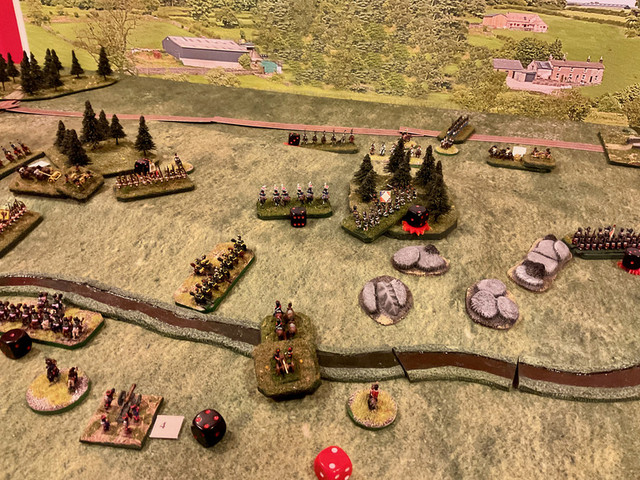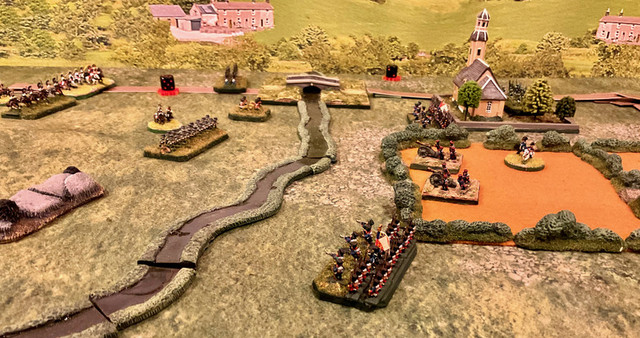(Note: I had meant to post this on my self-imposed timeline of Napoleonic Thursday, but will have to settle for Saturday evening.)
I had mentioned in a previous blog post that I had taken a flyer on Absolute Emperor (AE), Boyd Bruce’s new Napoleonic rules, published this year in Osprey’s “blue book” rules series. Thanks to my son John, who came out from the west coast to spend the last week of August with his old man, I’ve had a chance to put down some figures and take these rules out on the road. What follows is not a comprehensive review, but some first impressions.

AE does what is says on the tin: it’s a basic, highly playable set of rules for a reasonably sized Napoleonic battle in 2-4 hours, so, a club game. Individual units (called divisions in the rules) are operate within corps, each commanded by a corps commander, which suggests that these are rules written for army level engagements. However, the fact that these individual units can assume a variety of tactical formations (line, march column, attack column, square, un/ limbered, columns of squadrons) makes the game feel like an engagement of brigades, with the maneuver elements being regiments/battalions/batteries. Judging from the examples of actions given by in the designer notes, Boyd Bruce also thinks of this as a regimental/brigade set of rules.
Therefore, the first thing that I would suggest is that the prospective player abandons any thought that these are rules for big battles. I think it would be fair to say that AE attempts to provide a fast and playable war-game that conveys some sense of the Napoleonic battlefield and the tactics involved at the regimental level. How does it succeed in that goal? I would say, moderately well.
My son John put it very well when he helped me try out AE after playing several games of Sharp Practice. “After all the tactics of Sharp Practice, these rules seem very chess-like to me”, he said, which I think is a fair comment about how these rules capture what is often called the Rock Paper Scissors quality of the Napoleonic battlefield.
Here are the quick outlines. Units are rated as Veteran, Seasoned, and Conscript with “Activation” rolls respectively of 3+, 4+, and 5+ on 1d6. Early on p.9, when these Activation ratings are given, the rules explain that these are also the rolls that these troop type need to hit when Shooting and in Combat (Melee). If you miss that explanation, you will roam the rest of the rules in vain to understand how to shoot and fight. Activation rolls are necessary for most units to charge, or for foot to form square when charged by cavalry.
Cavalry are of two types, Light and Line. The only difference I can tell is that Light Cavalry don't get a charge bonus in Combat vs. Line cavalry.
Units in shooting and combat get different numbers of dice depending on their formation, thus a line veteran infantry unit rolls 4d6 in fire combat and hits on a 3+. Infantry in Combat gets 2d6 in Attack Column with a +1d6 Charge Bonus (+2d6 for non-Conscript French if between 1805-1809) so a Seasoned French unit in Attack Column Charging in 1805 gets 4d6 in the first round, hitting on 4+.
Artillery isn’t rated by quality; it generally gets 2d6 when shooting and hits on a 5+ with one dice if at effective range and 5+ hitting with two dice if in close (canister) range.
Units lose a step in quality when they take 5 hits and they are eliminated when they take 8 hits. In Close Combat, after a round of Shooting, whole units can disappear quickly, so the rules feel quick and bloody.
Commanders get varying numbers of Elan points, more Elan points = the better commander. The total number of all friendly commanders' Elan points means that the player with the lower total moves first, then the player with more Elan moves second, this giving the player with the better generals the opportunity to react to the other guys' moves. Shooting and Combat results are simultaneous. Generals can spend one Elan point each turn to either re-roll one die, allow a unit to rally, re-roll an activation, or change their Corps’ orders (more on that later).
That’s a quick overview of the rules, and most of what you need to know to play.
In this photo, John and I are trying out the third of the teaching scenarios included in the rule book using my 6mm figures. My French are on the right, John’s Austrians are on the left. Using the 6/10mm distances for AE, we began with the French just within artillery range (12”) with three batteries forming a Grand Battery (allowed for in the advanced rules), two units of high quality infantry, and a light cavalry unit facing one Austrian battery, one low quality (Conscript) infantry unit, two medium (Seasoned) quality infantry units, and one line cavalry unit. The Austrians have the advantage of defending a Built Up Area, and the French only have 12 turns to win, so it’s an interesting match up.
We had a decision before 12 turns. John deployed his better infantry parallel to the BUA, exposing it to the devastating fire of the Grand Battery, while my infantry and cavalry approached, forcing his infantry into square to hasten they destruction from th French cannon. My other infantry checked John’s cavalry by forming square, thus allowing the rest of my force to drive the Austrians out of the town. We had the rules figured out reasonably quickly and there were some interesting choices to be made, so a tidy game experience.

You’ll notice in this first photo that each unit has two bases, one in front of the other. This represented our initial attempt to follow the rules for tactical formation, so that doubled the frontage of foot units when they went from column to line, and then put the two foot bases back to back when forming square. The next time I played the rules in a solo game, I just used single bases to represent each unit, and mentally kept track of the formations (march/attack column, line) without any trouble. The extra stands on the table didn’t really add anything to my experience of the game so I binned it.
In the second game, I used AE's point system to create a smaller Austrian force (two divisions of infantry, one division of light cavalry and one of line cavalry) versus two larger French infantry divisions and one of French light cavalry. The points system uses some national characteristics - French generals are generally better than Austrian generals, which mean that they can command larger divisions. When building my divisions, I immediately noticed that there are no requirements for a player to select poor quality units, no ratios limiting the number of veteran/elite vs seasoned/conscript. Thus, two players could just fight with small numbers of crack units if they wanted to.
Here is the setup for the second game. At first I wanted to make the stream impassable except at the bridges, but that would make for a dull game fought over two chokepoints, so I just made the stream difficult terrain (takes a full turn to cross). The central hill has impassable terrain on the right (shown by the rock markers) but the centre/left can be climbed. The Austrians set up first, holding the stream with their two infantry divisions and the cavalry in reserve to address any breakthroughs.

I gave the French on the right two batteries to hasten the chances of a breakthrough and tie up the Austrian cavalry, while the main French effort is on the left wing where the cavalry will support the infantry attack on the hill.
By turn three the game is well underway. In the photo below, the black dice behind the French unit crossing the stream shows hits from the Austrian battery at the top. Two hits in one turn will cause a unit to Halt, preventing it from charging and closing to combat in that turn, unless its commander wants to use a point of Elan to rally it so it can charge in the Combat phase.
You’ll also notice a numbered chit beside the French battery at bottom centre. I like the optional rule in AE giving batteries ammunition limits (4 shots at full strength, 4 shots at half strength and then the battery is removed from play). Otherwise, there is no incentive for the stronger player to not just smash the enemy into submission before going in for the kill, which is essentially how I used my Grand Battery in my first game with my son John.
Also notice the French infantry which has crossed the stream and will then CHARGE the Austrian line cavalry which failed its Activation roll to charge the French foot. Say what? Yes, the rules make no prohibitions against infantry charging cavalry, the deterrent being that if infantry not in square loses a combat with cavalry, then the infantry is destroyed. Well, this is a test game, so I tried it, and the French foot won! True grognards might shake their heads at that.

Having won the Combat, the French infantry sidesteps into the wood on its next move, and allows the lancers behind to move up and finish off the Austrian horse in the next turn. Lancers are Light Cavalry, so don't get a Charge Bonus vs Line Cavalry, but the rules didn't say anything about them getting their Lance bonus in the first round. Therein is seen again one of the contradictions in AE, that a game for Big Battles still gives certain cavalry a weapon type bonus, but I guess the counter argument is why paint lancers if you can't have some fun with them?
With the centre shattered, the Austrians concede the game and begin their withdrawal. Thus, a decisive result within an hour of play (plus another hour of reading and head scratching), which is in keeping with AE’s ethos of a fast game, a laugh, and a pint afterwards.

As you can see from these two battles, it doesn’t take long to figure out the basics, and AE delivers a fast result with a minimum of complexity. I could certainly see it working for a quick game on club night.
What didn’t I like about AE? First, the rules feel hastily written. I’ve already mentioned how the centrality of the Activation numbers is very quickly explained. There are likewise some situations where I could find absolutely no guidance from the rules, particularly in Combat (Melee). What happens when both sides score the same number of hits in Combat? The rules say that if three hits are scored on a unit in Combat, it Recoils from Combat 1” and becomes Disorderd, so if both sides score 3 hits each I guess they both bounce back, but what if both sides only score 1 or 2 hits each in Combat? I scratched my head in vain.
Some people on Twitter defend the author and blame Osprey for a bad job of editing. That may be, but the author does spend a lot of ink on design notes, often beating a straw man of overly complex rules that have burdened Napoleonics in past, and touting his simpler is better philosophy. I would rather he have spent the ink making his rules clearer.
The Orders system likewise is interesting but ultimately seems unnecessary to me. Corps can be ordered to Attack or Defend (fairly obvious), Hold (sit tight a set number of turns until they Attack something), Flank March (one order per side per game), or Retreat. First, in a game system that boasts of being easy to play, an Orders system that hearkens back to the Naps rules of the 1980s and 1990s feels like a wrong turn. Most of these Orders are obvious, and if one wanted to write overly specific orders (eg, attack the woods to the north of the village), that would be more detail than the spirit of the rules would seem to tolerate. Again, there are also some ambiguities. Does a Flank March automatically succeed once the specified number of elapsed turns is reached? Do the units in a Flank March appear anywhere on the specified flank of the table? The rules suggest yes, the flankers appear where you want, when you want, as long as the turn number is written down ahead of time. That would have made Grouchy’s life easier at Waterloo!
Finally, I wanted to like the Elan rules, and while it can be useful to take a re-roll or allow a unit to ignore a Halt result before a critical charge, I sometimes found myself forgetting the commanders altogether. One could make them more vital with a house rule saying that units can only move if within command range of their Corps Cdr or their CinC.
I don’t want this review to seem harshly critical. I commend Boyd Bruce, and anyone for that matter, for writing a set of rules and then for getting someone like Osprey to publish them. AE would be a quick way to get a player new to Napoleonics into their first game and have some fun doing it. It’s thus a useful entry into Naps wargaming, and could b adopted for fast pickup games when players can’t decide on more complicated rules systems.
For me, I found AE to be less than fully compelling. If I wanted a crunchier rule system with some tactical considerations, with more experienced players, I’d consider Sam Mustafa’s LsSalle or Dave Brown’s General d’Armee. If I wanted a set of rules for big battles where the units truly were Corps and Divisions, I would probably choose Mustafa’s Blucher.
All that being said, Absolute Emperor gets half a Mad Padre blessing.
There are lots of blog posts on AE out there: here’s another perspective.
Cheers,
MP+


Have found that Osprey rules publications can tend to be 50/50 as to whether they’ll end up fun and playable or not. Thanks for the review Mike, should I ever dip my toe (back) into Napoleonics, I think I’ll pass up on these rules
ReplyDeleteThanks Dai. It’s a mixed bag with Osprey to be sure. Their Dragon Rampant rules are the best value for gaming money I’ve ever gotten from a $25 book, and I have high hopes for Keith Flint’s Honours of War SYW rules, so not all bad. And there’s certainly no shortage of Naps rules if you’re looking to dip that toe again!
DeleteThanks for the review! Seems like a perfectly reasonable entry level set (I certainly wouldn't describe GdA that way!). I don't need one, but plenty of others may.
ReplyDeleteThat's a very good take on it
DeleteThanks for reading!
DeleteA very helpful review. Thanks for taking the time to write it up.
ReplyDeleteCheers, you’re most welcome!
DeleteI'll give them a try with you.
ReplyDeleteBut maybe Sharp Practice will be our "go to" game
Happy to try them again but honestly I’d rather play Blucher with you again.
DeleteThat would also be good
DeleteThanks for this detailed overview and review. The impressions of players who have actually used rules are always helpful, particularly when combined with a bit of background and experience in the period. The summaries of the rules that I have read were sufficient for me to not have this on my list. It is now double-crossed out.
ReplyDeleteIf, as Peter suggests above, it helps some people to get into Napoleonics, then it will have done a good service. They can then learn more and progress to other sets (or perhaps stick with a simple game that has some of the elements of Napoleonic warfare).
Regards, James